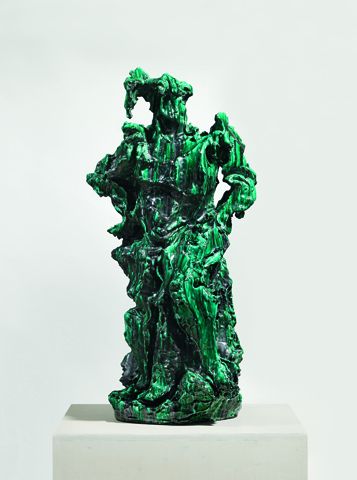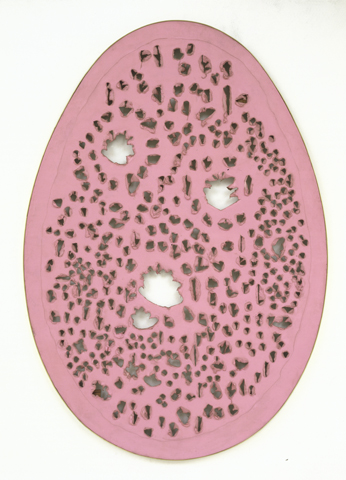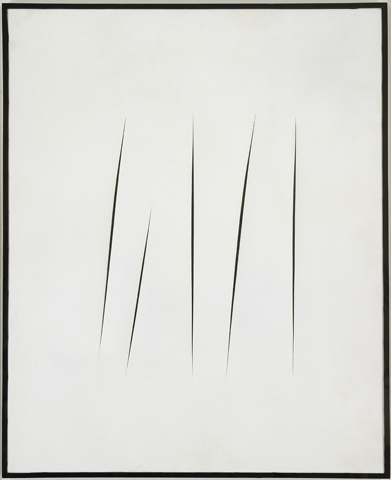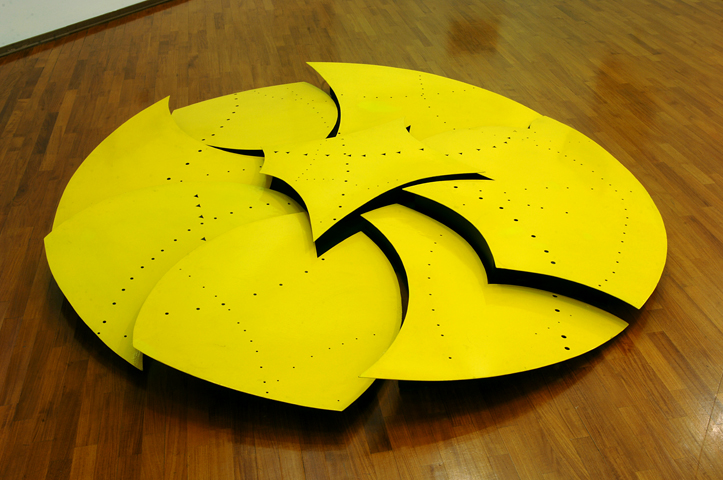The (W)Hole Art of Lucio Fontana at the MAMVP
- (first published on artlifemagazine.com)
- May 26, 2014
- 4 min read
Updated: Mar 24, 2020
Paris. In a big retrospective show, the MAMVP (Municipal Modern Art Museum of Paris) presents Lucio Fontana (1899-1968) as an artist who united the extremes: his works surpass the traditional definitions of sculpture and painting, of abstraction and realism.
It all started in the early 1930’s with Primitivism: the appropriation of classical models in a truly modern turn to pre-modernity. Few of these works are simple copies of the classic (Greek) style, such The Harpunier (Bronze, 1933/34); Lucio Fontana was more interested in the Stone Ager within, in continuities and remains. This seems to be true even on a (pseudo-)psychological level: with paintings of hairy, green- and blue-skinned cavemen approaching rather naturalistic women (Lovers; or Figures, both 1932). But more so in relation to the technics of art: Experimenting with different materials from terracotta to bronze to cement, and the effects of pure colour as an autonomous part of the work, Lucio Fontana searched for a the common point as a new start. Were these the 90’s we would write of postmodernist sampling, as the artist mixed material and colour with no respect for tradition. On the inside of small sculptures a painting appears (Figure Negre, 1931). Hack off everything that’s not - a painting?
The show continues to trace the early days of Fontana’s career with drawings and cement objects. These works form a counterpoint to rigid geometrical “abstractisms”: the lines aren’t straight, the curves not even – it’s Primitivism again, this time focused on the unskilled, on children’s drawings (or people like us who could never draw a straight line without the help of a ruler), yet it looks just right. This nonconformist Primitivism picked up pieces to project them into the future.
And the fusion of material and colour, of three-dimensional sculpture and two-dimensional painting continues. It’s hard to decide, whether Lucio Fontana’s ceramic collection of sea critters (pulps, shellfish, etc.) is abstract or realistic; there are biological forms, but not only. At the same time, human forms are abstracted by different means. The Portrait of Teresita appears as a glittering overkill, the technique being polychrome mosaics. And the Italian Torso of 1938 is easily recognisable as a human figure, but is it naked or carrying an armour (a toga?); are these decorations on the chest meant to protrude, to be another “physical” layer, or a visual one?
After these lengthy experimentations with colour and form (which of course lay in the air of the times that saw a new movement every other week), Lucio Fontana wrote the first manifesto of Spatialism in 1946. It postulated the abandon of traditional form in favour of the “union of space and time”. Later, Spatialism would be merged with Michel Tapiés art informel.
Much of Lucio Fontana’s work did not change fundamentally, though. He continued his fusions just like before. But the artist is, of course, best known for no-things: holes that now appear for the first time. They pierce canvas and sculptures likewise. Light falls through the gaps in the work, shadows appear, and the image gains movement. Space is the sum of nothing, every hole a created emptiness. Only in a few exceptions these holes, that may be triangular or round, are polished, cleaned up (Concept Spatiale of 1952, a unique object originally meant to be stepped upon). But mostly they appear like bullet holes, proudly presenting the impact wound. We can trace them back to their creation and the direction it followed.
There is an interesting quote by Fontana saying: “A butterfly in flight stimulates my imagination. By freeing myself from discourse, I loose myself in time and I start making holes”. Holes in reality. It’s hard not to think of Chuang Tse here (“Now I do not know whether I was then a man dreaming I was a butterfly, or whether I am now a butterfly, dreaming I am a man”).
What was visible since the first spatial holes takes more and more place: where a hole is created, dents, scars, appear. Later, for every bit that’s taken away, even more matter is added onto the canvas (or the sculpture). Painted stones, or painted forms on colour fields on a canvas holed like a Swiss cheese.
At the end of the 1950s, a new motif appears, the holes become cuts, or scratches. There are the obvious connotations of violence and eroticism (and Fontana was very aware of this point, as show some explicit drawings. Yet, he somehow mitigated the impression in making the scratches clean and even). Danger’s lurking behind the canvas, something tore apart our vision of the world, ready to strike again. Fontana explained: “We have entered the Space Age. Mankind has measured the distances between planets and has sought to conquer them. ... (He) has engaged humanity in a search for the impossible.”
Consequently, the objects from a series named Nature resemble meteorites, fallen down to earth after a journey through space. But what is space? Is it even possible to comprehend the question, and is this the menace? All is represented by nothing, a lack of understanding is a hole, a cut in the mind’s possibilities. Absence is a reality, and to be is not to be. The (w)hole of it. And we may enter Lucio Fontana’s space: a shallow maze first shown at documenta 4 in 1968 (Ambiente Spazale Bianco). Not a patio, but a “spatio”.
Like so many others, at the end of his life, Lucio Fontana turned to religion. The End of God is a series of egg-shaped paintings with holes, they might or might not appear to us as a face. The artist explains, “God is nothing but means everything”. Again the unification of extremes, yin and yang.
Oh, and instead of an audioguide, we recommend Serge Gainsbourgh's 1959 song "Le poinçonneur des lilas" to accompany your visit ("I make holes, little holes, still more little holes,...").
Lucio Fontana, Rétrospective, 25 April-24 August 2014, MAMVP, Paris










Comments